Quantifying Drivers of Coastal Forest Carbon Decline Highlights Opportunities for Targeted Human Interventions
Abstract
:1. Introduction
2. Materials and Methods
2.1. Study System
2.2. Mapping Coastal Forest Carbon Declines
2.3. Selecting and Mapping Driver Variables
2.3.1. Land Use Drivers
2.3.2. Sea Level Rise Drivers
2.3.3. Natural Disturbance Drivers
2.4. Statistical Modeling Approach
2.5. Predicting Future Coastal Forest Carbon Declines from Sea Level Rise
3. Results
3.1. Statistical Modeling of Coastal Forest Declines
3.2. Future Coastal Forest Declines
4. Discussion
5. Conclusions
Supplementary Materials
Author Contributions
Funding
Institutional Review Board Statement
Informed Consent Statement
Data Availability Statement
Acknowledgments
Conflicts of Interest
References
- Costanza, R.; de Groot, R.; Sutton, P.; Van der Ploeg, S.; Anderson, S.J.; Kubiszewski, I.; Farber, S.; Turner, R.K. Changes in the global value of ecosystem services. Glob. Environ. Chang. 2014, 26, 152–158. [Google Scholar] [CrossRef]
- Krauss, K.W.; Noe, G.B.; Duberstein, J.A.; Conner, W.H.; Stagg, C.L.; Cormier, N.; Jones, M.C.; Bernhardt, C.E.; Graeme Lockaby, B.; From, A.S.; et al. The role of the upper tidal estuary in wetland blue carbon storage and flux. Glob. Biogeochem. Cycles 2018, 32, 817–839. [Google Scholar] [CrossRef]
- Barbier, E.B.; Hacker, S.D.; Kennedy, C.; Koch, E.W.; Stier, A.C.; Silliman, B.R. The value of estuarine and coastal ecosystem services. Ecol. Monogr. 2011, 81, 169–193. [Google Scholar] [CrossRef]
- Aguilos, M.; Mitra, B.; Noormets, A.; Minick, K.; Prajapati, P.; Gavazzi, M.; Sun, G.; McNulty, S.; Li, X.; Domec, J.C.; et al. Long-term carbon flux and balance in managed and natural coastal forested wetlands of the Southeastern USA. Agric. Forest Meteorol. 2020, 288, 108022. [Google Scholar] [CrossRef]
- Arkema, K.K.; Verutes, G.M.; Wood, S.A.; Clarke-Samuels, C.; Rosado, S.; Canto, M.; Rosenthal, A.; Ruckelshaus, M.; Guannel, G.; Toft, J.; et al. Embedding ecosystem services in coastal planning leads to better outcomes for people and nature. Proc. Natl. Acad. Sci. USA 2015, 112, 7390–7395. [Google Scholar] [CrossRef] [Green Version]
- Enwright, N.M.; Griffith, K.T.; Osland, M.J. Barriers to and opportunities for landward migration of coastal wetlands with sea-level rise. Front. Ecol. Environ. 2016, 14, 307–316. [Google Scholar] [CrossRef]
- Kopp, R.E.; Kemp, A.C.; Bittermann, K.; Horton, B.P.; Donnelly, J.P.; Gehrels, W.R.; Hay, C.C.; Mitrovica, J.X.; Morrow, E.D.; Rahmstorf, S. Temperature-driven global sea-level variability in the Common Era. Proc. Natl. Acad. Sci. USA 2016, 113, E1434–E1441. [Google Scholar] [CrossRef] [PubMed] [Green Version]
- Jones, M.C.; Bernhardt, C.E.; Krauss, K.W.; Noe, G.B. The impact of late Holocene land use change, climate variability, and sea level rise on carbon storage in tidal freshwater wetlands on the southeastern United States coastal plain. J. Geophys. Res. Biogeosci. 2017, 122, 3126–3141. [Google Scholar] [CrossRef] [Green Version]
- Law, B.E.; Hudiburg, T.W.; Berner, L.T.; Kent, J.J.; Buotte, P.C.; Harmon, M.E. Land use strategies to mitigate climate change in carbon dense temperate forests. Proc. Natl. Acad. Sci. USA 2018, 115, 3663–3668. [Google Scholar] [CrossRef] [Green Version]
- Ardón, M.; Morse, J.L.; Colman, B.P.; Bernhardt, E.S. Drought-induced saltwater incursion leads to increased wetland nitrogen export. Glob. Chang. Biol. 2013, 19, 2976–2985. [Google Scholar] [CrossRef]
- Herbert, E.R.; Boon, P.; Burgin, A.J.; Neubauer, S.C.; Franklin, R.B.; Ardón, M.; Hopfensperger, K.N.; Lamers, L.P.; Gell, P. A global perspective on wetland salinization: Ecological consequences of a growing threat to freshwater wetlands. Ecosphere 2015, 6, 1–43. [Google Scholar] [CrossRef]
- Ardón, M.; Helton, A.M.; Bernhardt, E.S. Drought and saltwater incursion synergistically reduce dissolved organic carbon export from coastal freshwater wetlands. Biogeochemistry 2016, 127, 411–426. [Google Scholar] [CrossRef]
- Mcleod, E.; Chmura, G.L.; Bouillon, S.; Salm, R.; Björk, M.; Duarte, C.M.; Lovelock, C.E.; Schlesinger, W.H.; Silliman, B.R. A blueprint for blue carbon: Toward an improved understanding of the role of vegetated coastal habitats in sequestering CO2. Front. Ecol. Environ. 2011, 9, 552–560. [Google Scholar] [CrossRef] [Green Version]
- Henman, J.; Poulter, B. Inundation of freshwater peatlands by sea level rise: Uncertainty and potential carbon cycle feedbacks. J. Geophys. Res. Biogeosci. 2008, 113. [Google Scholar] [CrossRef]
- Chmura, G.L.; Anisfeld, S.C.; Cahoon, D.R.; Lynch, J.C. Global carbon sequestration in tidal, saline wetland soils. Glob. Biogeochem. Cycles 2003, 17. [Google Scholar] [CrossRef]
- Donato, D.C.; Kauffman, J.B.; Murdiyarso, D.; Kurnianto, S.; Stidham, M.; Kanninen, M. Mangroves among the most carbon-rich forests in the tropics. Nat. Geosci. 2011, 4, 293. [Google Scholar] [CrossRef]
- Loder, A.L.; Finkelstein, S.A. Carbon accumulation in freshwater marsh soils: A synthesis for temperate North America. Wetlands 2020, 40, 1173–1187. [Google Scholar] [CrossRef]
- Williams, K.; Ewel, K.C.; Stumpf, R.P.; Putz, F.E.; Workman, T.W. Sea-level rise and coastal forest retreat on the west coast of Florida, USA. Ecology 1999, 80, 2045–2063. [Google Scholar] [CrossRef]
- Poulter, B.; Qian, S.S.; Christensen, N.L. Determinants of coastal treeline and the role of abiotic and biotic interactions. Plant Ecol. 2009, 202, 55–66. [Google Scholar] [CrossRef]
- Desantis, L.R.; Bhotika, S.; Williams, K.; Putz, F.E. Sea-level rise and drought interactions accelerate forest decline on the Gulf Coast of Florida, USA. Glob. Chang. Biol. 2007, 13, 2349–2360. [Google Scholar] [CrossRef]
- Brinson, M.M.; Christian, R.R.; Blum, L.K. Multiple states in the sea-level induced transition from terrestrial forest to estuary. Estuaries 1995, 18, 648–659. [Google Scholar] [CrossRef]
- Moorhead, K.K.; Brinson, M.M. Response of wetlands to rising sea level in the lower coastal plain of North Carolina. Ecol. Appl. 1995, 5, 261–271. [Google Scholar] [CrossRef]
- Kirwan, M.L.; Gedan, K.B. Sea-level driven land conversion and the formation of ghost forests. Nat. Clim. Chang. 2019, 9, 450–457. [Google Scholar] [CrossRef] [Green Version]
- Sallenger, A.H.; Doran, K.S.; Howd, P.A. Hotspot of accelerated sea-level rise on the Atlantic coast of North America. Nat. Clim. Chang. 2012, 2, 884–888. [Google Scholar] [CrossRef]
- Sweet, W.V.; Marra, J.J. 2015 State of U.S. Nuisance Tidal Flooding. Supplement to State of the Climate: National Overview for May 2016; National Oceanic and Atmospheric Administration, National Centers for Environmental Information: Asheville, NC, USA, 2016; p. 5. Available online: https://www.ncdc.noaa.gov/monitoring-content/sotc/national/2016/may/sweet-marra-nuisance-flooding-2015.pdf (accessed on 1 December 2018).
- Karegar, M.A.; Dixon, T.H.; Engelhart, S.E. Subsidence along the Atlantic Coast of North America: Insights from GPS and late Holocene relative sea level data. Geophys. Res. Lett. 2016, 43, 3126–3133. [Google Scholar] [CrossRef] [Green Version]
- Poulter, B.; Halpin, P.N. Raster modelling of coastal flooding from sea-level rise. Int. J. Geogr. Inf. Sci. 2008, 22, 167–182. [Google Scholar] [CrossRef]
- Field, C.R.; Dayer, A.A.; Elphick, C.S. Landowner behavior can determine the success of conservation strategies for ecosystem migration under sea-level rise. Proc. Natl. Acad. Sci. USA 2017, 114, 9134–9139. [Google Scholar] [CrossRef] [Green Version]
- White, E.; Kaplan, D. Restore or retreat? Saltwater intrusion and water management in coastal wetlands. Ecosyst. Health Sustain. 2017, 3, e01258. [Google Scholar] [CrossRef] [Green Version]
- Stagg, C.L.; Baustian, M.M.; Perry, C.L.; Carruthers, T.J.; Hall, C.T. Direct and indirect controls on organic matter decomposition in four coastal wetland communities along a landscape salinity gradient. J. Ecol. 2018, 106, 655–670. [Google Scholar] [CrossRef]
- Fatoyinbo, T.; Feliciano, E.A.; Lagomasino, D.; Lee, S.K.; Trettin, C. Estimating mangrove aboveground biomass from airborne LiDAR data: A case study from the Zambezi River delta. Environ. Res. Lett. 2018, 13, 025012. [Google Scholar] [CrossRef] [Green Version]
- Klemas, V.V. Remote sensing of landscape-level coastal environmental indicators. Environ. Manag. 2001, 27, 47–57. [Google Scholar] [CrossRef] [PubMed]
- DeFries, R.S.; Houghton, R.A.; Hansen, M.C.; Field, C.B.; Skole, D.; Townshend, J. Carbon emissions from tropical deforestation and regrowth based on satellite observations for the 1980s and 1990s. Proc. Natl. Acad. Sci. USA 2002, 99, 14256–14261. [Google Scholar] [CrossRef] [PubMed] [Green Version]
- Byrd, K.B.; O’Connell, J.L.; Di Tommaso, S.; Kelly, M. Evaluation of sensor types and environmental controls on mapping biomass of coastal marsh emergent vegetation. Remote Sens. Environ. 2014, 149, 166–180. [Google Scholar] [CrossRef]
- Lefsky, M.; Warren, B.; Hardings, D.J.; Parker, G.G.; Ackery, S.A.; Gower, S.T. Lidar remote sensing of above-ground biomass in three biomes. Environ. Res. 2002, 11, 393–399. [Google Scholar] [CrossRef] [Green Version]
- Lim, K.; Treitz, P.; Baldwin, K.; Morrison, I.; Green, J. Lidar remote sensing of biophysical properties of tolerant northern hardwood forests. Can. J. Remote Sens. 2003, 29, 658–678. [Google Scholar] [CrossRef]
- Anderson, J.; Martin, M.E.; Smith, M.-L.; Dubayah, R.O.; Hofton, M.A.; Hyde, P.; Peterson, B.E.; Blair, J.B.; Knox, R.G. The use of waveform lidar to measure northern temperate mixed conifer and deciduous forest structure in New Hampshire. Remote Sens. Environ. 2006, 105, 248–261. [Google Scholar] [CrossRef]
- Fatoyinbo, T.E.; Simard, M. Height and biomass of mangroves in Africa from ICESat/GLAS and SRTM. Int. J. Remote Sens. 2013, 34, 668–681. [Google Scholar] [CrossRef]
- Sexton, J.O.; Bax, T.; Siqueira, P.; Swenson, J.J.; Hensley, S. A comparison of lidar, radar, and field measurements of canopy height in pine and hardwood forests of southeastern North America. For. Ecol. Manag. 2009, 257, 1136–1147. [Google Scholar] [CrossRef]
- Riegel, J.B.; Bernhardt, E.; Swenson, J. Estimating above-ground Carbon Biomass in a Newly Restored Coastal Plain Wetland Using Remote Sensing. PLoS ONE 2013, 8, e68251. [Google Scholar] [CrossRef]
- Kulawardhana, R.W.; Popescu, S.C.; Feagin, R.A. Fusion of lidar and multispectral data to quantify salt marsh carbon stocks. Remote Sens. Environ. 2014, 154, 345–357. [Google Scholar] [CrossRef]
- Hudak, A.T.; Strand, E.K.; Vierling, L.A.; Byrne, J.C.; Eitel, J.U.H.; Martinuzzi, S.; Falkowski, M.J. Quantifying aboveground forest carbon pools and fluxes from repeat LiDAR surveys. Remote Sens. Environ. 2012, 123, 25–40. [Google Scholar] [CrossRef] [Green Version]
- Økseter, R.; Bollandsås, O.M.; Gobakken, T.; Næsset, E. Modeling and predicting aboveground biomass change in young forest using multi-temporal airborne laser scanner data. Scand. J. For. Res. 2015, 30, 458–469. [Google Scholar] [CrossRef]
- Cao, L.; Coops, N.C.; Innes, J.L.; Sheppard, S.R.J.; Fu, L.; Ruan, H.; She, G. Estimation of forest biomass dynamics in subtropical forests using multi-temporal airborne LiDAR data. Remote Sens. Environ. 2016, 178, 158–171. [Google Scholar] [CrossRef]
- Hudak, A.T.; Fekety, P.A.; Kane, V.R.; Kennedy, R.E.; Filippelli, S.K.; Falkowski, M.J.; Tinkham, W.T.; Smith, A.M.; Crookston, N.L.; Domke, G.M.; et al. A carbon monitoring system for mapping regional, annual aboveground biomass across the northwestern USA. Environ. Res. Lett. 2020, 15, 095003. [Google Scholar] [CrossRef]
- Byrd, K.B.; Windham-Myers, L.; Leeuw, T.; Downing, B.; Morris, J.T.; Ferner, M.C. Forecasting tidal marsh elevation and habitat change through fusion of Earth observations and a process model. Ecosphere 2016, 7, e01582. [Google Scholar] [CrossRef]
- Hamilton, S.E.; Friess, D.A. Global carbon stocks and potential emissions due to mangrove deforestation from 2000 to 2012. Nat. Clim. Chang. 2018, 8, 240–244. [Google Scholar] [CrossRef] [Green Version]
- Lagomasino, D.; Fatoyinbo, T.; Lee, S.; Feliciano, E.; Trettin, C.; Shapiro, A.; Mangora, M.M. Measuring mangrove carbon loss and gain in deltas. Environ. Res. Lett. 2019, 14, 025002. [Google Scholar] [CrossRef]
- Smart, L.S.; Taillie, P.J.; Poulter, B.; Vukomanovic, J.; Singh, K.K.; Swenson, J.J.; Mitasova, H.; Smith, J.W.; Meentemeyer, R.K. Aboveground carbon loss associated with the spread of ghost forests as sea levels rise. Environ. Res. Lett. 2020, 15, 104028. [Google Scholar] [CrossRef]
- Foody, G.M. Spatial nonstationarity and scale-dependency in the relationship between species richness and environmental determinants for the sub-Saharan endemic avifauna. Glob. Ecol. Biogeogr. 2004, 13, 315–320. [Google Scholar] [CrossRef]
- Fotheringham, S.; Brundson, C.; Charlton, M. Geographically Weighted Regression & Associated Techniques; John Wiley & Sons: West Sussex, UK, 2003. [Google Scholar]
- Mason, S.A.; Olander, L.P.; Grala, R.K.; Galik, C.S.; Gordon, J.S. A practice-oriented approach to foster private landowner participation in ecosystem service conservation and restoration at a landscape scale. Ecosyst. Serv. 2020, 46, 101203. [Google Scholar] [CrossRef]
- Bhattachan, A.; Jurjonas, M.D.; Moody, A.C.; Morris, P.R.; Sanchez, G.M.; Smart, L.S.; Taillie, P.J.; Emanuel, R.E.; Seekamp, E.L. Sea level rise impacts on rural coastal social-ecological systems and the implications for decision making. Environ. Sci. Policy 2018, 90, 122–134. [Google Scholar] [CrossRef]
- National Oceanic and Atmospheric Administration (NOAA). 2001 NCFMP Lidar: Phase. 2012. Available online: https://chs.coast.noaa.gov/htdata/lidar1_z/geoid18/data/1397/ (accessed on 1 December 2016).
- National Oceanic and Atmospheric Administration (NOAA). 2014 NCFMP Lidar: Phase. 2014. Available online: https://chs.coast.noaa.gov/htdata/lidar1_z/geoid18/data/4954/ (accessed on 1 December 2016).
- US Geographical Survey (USGS). 2018 GloVis Data Warehouse. Available online: http://glovis.usgs.gov (accessed on 15 December 2016).
- Taillie, P.J.; Moorman, C.E.; Poulter, B.; Ardón, M.; Emanuel, R.E. Decadal-scale vegetation change driven by salinity at leading edge of rising sea level. Ecosystems 2019, 22, 1918–1930. [Google Scholar] [CrossRef]
- Smith, W.B.; Brand, G.J. Allometric biomass equations for 98 species of herbs, shrubs, and small trees. In Research Note NC-299; US Dept. of Agriculture, Forest Service, North Central Forest Experiment Station, 299: St. Paul, MN, USA, 1983. [Google Scholar]
- Jenkins, J.C.; Chojnacky, D.C.; Heath, L.S.; Birdsey, R.A. National-scale biomass estimators for United States tree species. For. Sci. 2003, 49, 12–35. [Google Scholar]
- Castillo, J.M.; Leira-Doce, P.; Rubio-Casal, A.E.; Figueroa, E. Spatial and temporal variations in aboveground and belowground biomass of Spartina maritima (small cordgrass) in created and natural marshes. Estuar. Coast. Shelf Sci. 2008, 78, 819–826. [Google Scholar] [CrossRef]
- Breiman, L. Random Forests. Mach. Learn. 2001, 45, 5–32. [Google Scholar] [CrossRef] [Green Version]
- Martin, A.R.; Doraisami, M.; Thomas, S.C. Global patterns in wood carbon concentration across the world’s trees and forests. Nat. Geosci. 2018, 11, 915–920. [Google Scholar] [CrossRef]
- National Ocean Service. Tides and Currents: Bench Mark Sheet for 8651370 2017, Duck NC. Available online: https://tidesandcurrents.noaa.gov/benchmarks.html?id=8651370 (accessed on 1 January 2018).
- MRLC. Multi-Resolution Land Characteristics Consortium: National Land Cover Database (NLCD) 2001. 2017. Available online: https://www.mrlc.gov/data?f%5B0%5D=category%3Aland%20cover&f%5B1%5D=year%3A2016 (accessed on 1 January 2017).
- Meentemeyer, R.K.; Tang, W.; Dorning, M.A.; Vogler, J.B.; Cunniffe, N.J.; Shoemaker, D.A. Futures: Multilevel simulations of emerging urban–rural landscape structure using a stochastic patch-growing algorithm. Ann. Assoc. Am. Geogr. 2013, 103, 785–807. [Google Scholar] [CrossRef] [Green Version]
- GRASS Development Team. Geographic Resources Analysis Support System (GRASS) Software, Version 7.2; Open Source Geospatial Foundation: Chicago, IL, USA, 2017; Available online: https://grass.osgeo.org/ (accessed on 1 January 2017).
- US Department of Agriculture (USDA). National Agricultural Statistics Service Cropland Data Layer: Published Crop-Specific Data Layer. 2018. Available online: https://nassgeodata.gmu.edu/CropScape/ (accessed on 1 December 2017).
- Google Earth Engine. A Planetary-Scale Platform for Earth Science Data & Analysis. 2018. Available online: https://earthengine.google.com/ (accessed on 1 December 2017).
- US Geological Survey (USGS). National Hydrography Geodatabase: The National Map Viewer. 2013. Available online: http://nhd.usgs.gov/data.html (accessed on 15 May 2016).
- US Environmental Protection Agency (US EPA). 2017 STORage and RETrieval Warehouse/Water Quality Exchange. Available online: www3.epa.gov/storet/bck/dbtop.html (accessed on 1 January 2017).
- Emadi, M.; Baghernejad, M. Comparison of spatial interpolation techniques for mapping soil pH and salinity in agricultural coastal areas, northern Iran Arch. Agron. Soil Sci. 2014, 60, 1315–1327. [Google Scholar] [CrossRef]
- Frost, C.C. Presettlement fire regimes in southeastern marshes, peatlands, and swamps. In Proceedings of the 19th Tall Timbers Fire Ecology Conference: Fire in Wetlands: A Management Perspective, Tallahassee, FL, USA, 1995; Tall Timbers Research Inc.: Tallahassee, FL, USA, 1995. Available online: http://talltimbers.org/wp-content/uploads/2014/03/Frost1995_op.pdf (accessed on 23 August 2016).
- US Forest Service (USFS); US Geological Survey (USGS). Monitoring Trends in Burn Severity (MTBS) Data Access: Fire Level Geospatial Data. 2017. Available online: http://mtbs.gov/direct-download (accessed on 1 May 2017).
- Harris, P.; Fotheringham, A.S.; Crespo, R.; Charlton, M. The use of geographically weighted regression for spatial prediction: An evaluation of models using simulated data sets. Math. Geosci. 2010, 42, 657–680. [Google Scholar] [CrossRef]
- Brunsdon, C.; Fotheringham, S.; Charlton, M. Geographically weighted regression. J. R. Stat. Soc. Ser. D 1998, 47, 431–443. [Google Scholar] [CrossRef]
- R Core Development Team. R: A Language and Environment for Statistical Computing; R Foundation for Statistical Computing: Vienna, Austria, 2018; Available online: https://www.R-project.org/ (accessed on 10 January 2018).
- Bivand, R.; Yu, D.; Nakaya, T.; Garcia-Lopez, M.A.; Bivand, M.R. Packag ‘Spgwr’. R Software Package. 2017. Available online: https://cran.r-project.org/web/packages/spgwr/index.html (accessed on 10 January 2018).
- NOAA Office for Coastal Management (NOAA OCM). Sea Level Rise Data Download. 2017. Available online: https://coast.noaa.gov/slrdata/ (accessed on 1 December 2017).
- Lindeman, R.H.; Merenda, P.F.; Gold, R.Z. Introduction to Bivariate and Multivariate Analysis; Scott, Foresman: Glenview, IL, USA, 1980. [Google Scholar]
- Su, S.; Li, D.; Xiao, R.; Zhang, Y. Spatially non-stationary response of ecosystem service value changes to urbanization in Shanghai, China. Ecol. Indic. 2014, 45, 332–339. [Google Scholar] [CrossRef]
- Bhattachan, A.; Emanuel, R.E.; Ardon, M.; Bernhardt, E.S.; Anderson, S.M.; Stillwagon, M.G.; Ury, E.A.; Bendor, T.K.; Wright, J.P. Evaluating the effects of land-use change and future climate change on vulnerability of coastal landscapes to saltwater intrusion. Elem. Sci. Anthr. 2018, 6, 62. [Google Scholar] [CrossRef] [Green Version]
- Poulter, B.; Goodall, J.L.; Halpin, P.N. Applications of network analysis for adaptive management of artificial drainage systems in landscapes vulnerable to sea level rise. J. Hydrol. 2008, 357, 207–217. [Google Scholar] [CrossRef]
- Tully, K.; Gedan, K.; Epanchin-Niell, R.; Strong, A.; Bernhardt, E.S.; BenDor, T.; Mitchell, M.; Kominoski, J.; Jordan, T.E.; Neubauer, S.C.; et al. The invisible flood: The chemistry, ecology, and social implications of coastal saltwater intrusion. BioScience 2019, 69, 368–378. [Google Scholar] [CrossRef]
- Rodrigues, J.G.; Conides, A.J.; Rivero Rodriguez, S.; Raicevich, S.; Pita, P.; Kleisner, K.M.; Pita, C.; Lopes, P.F.; Alonso Roldáni, V.; Ramos, S.S.; et al. Marine and coastal cultural ecosystem services: Knowledge gaps and research priorities. One Ecosyst. 2017, 2, e12290. [Google Scholar] [CrossRef]
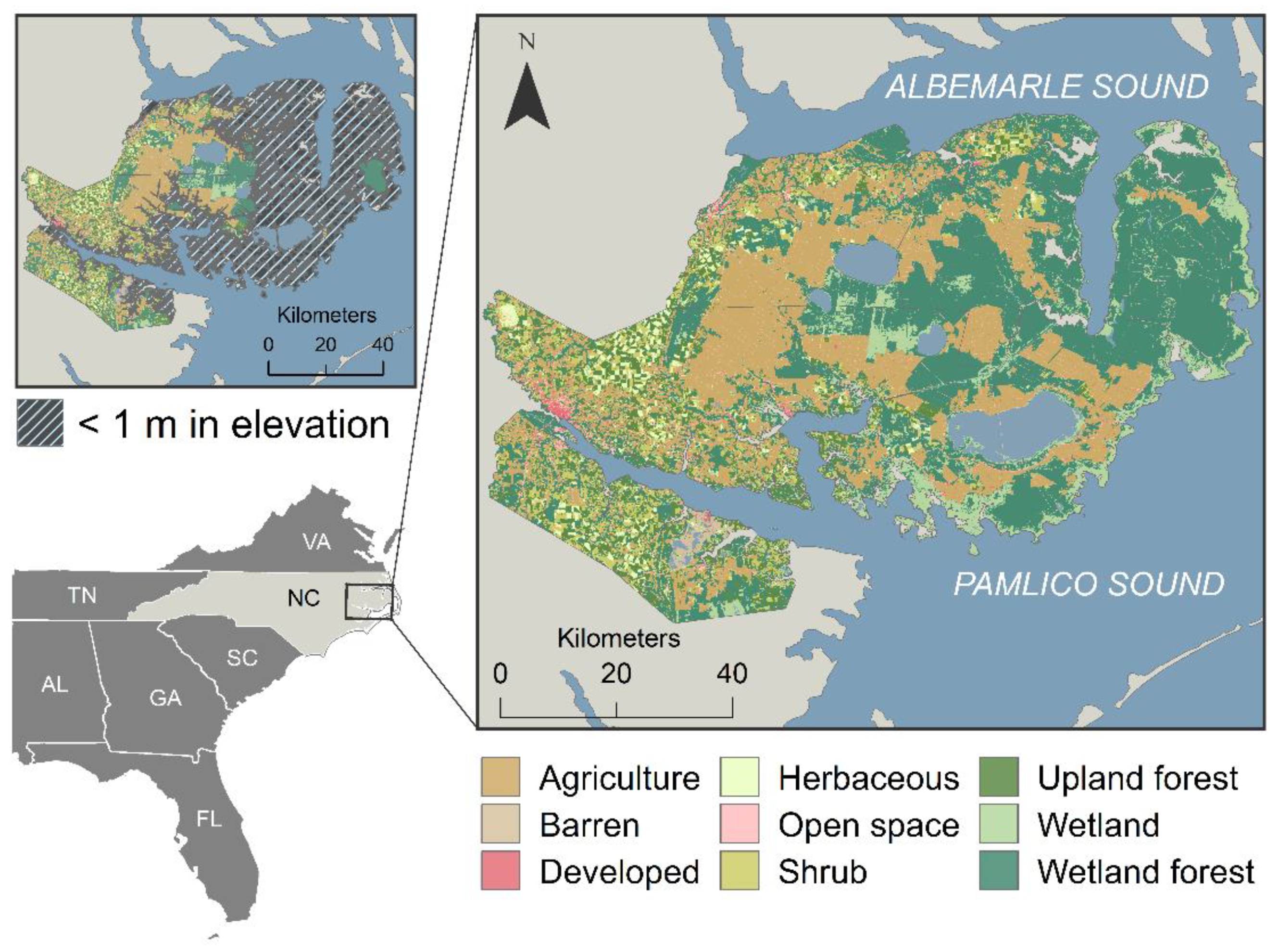
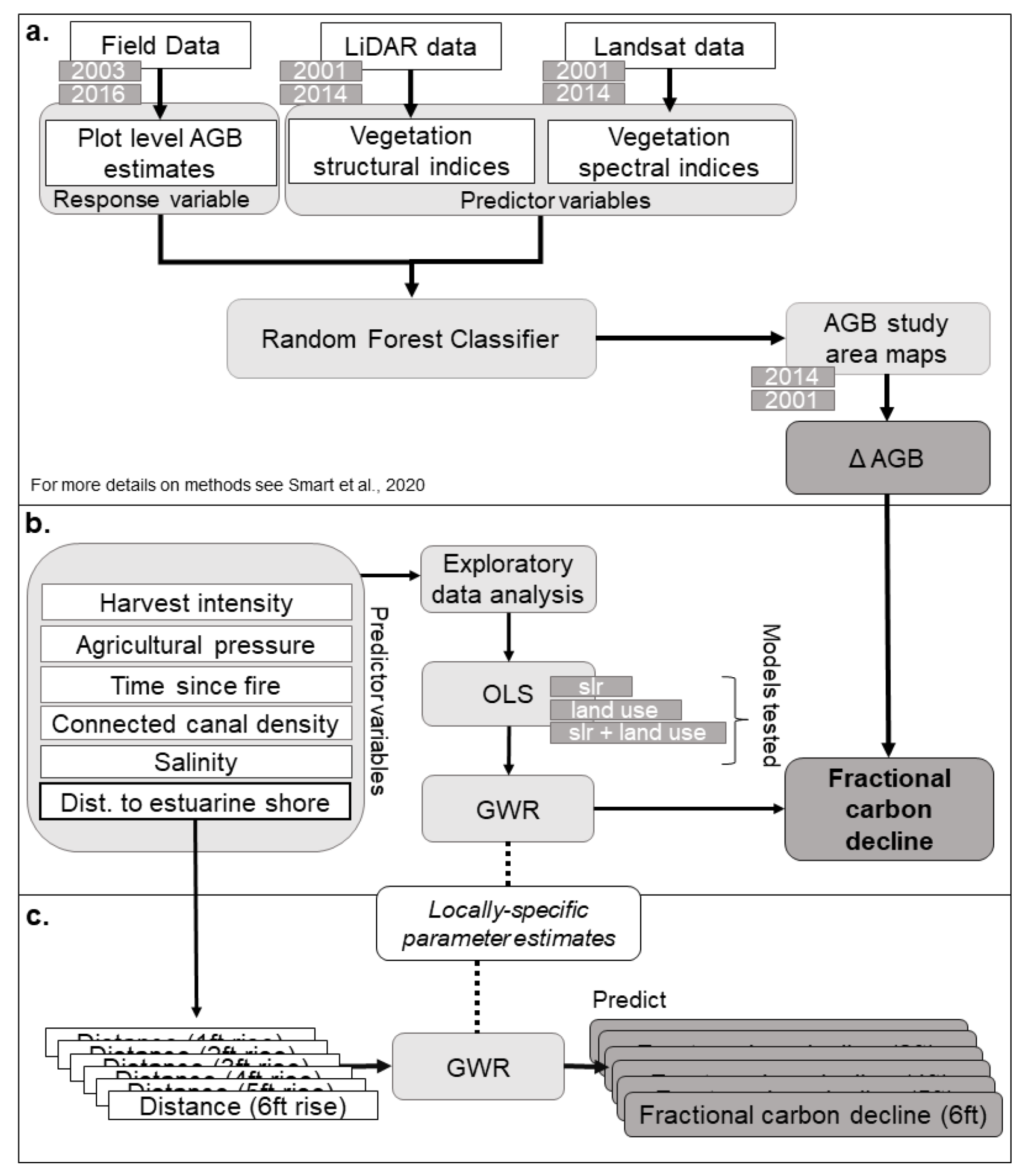
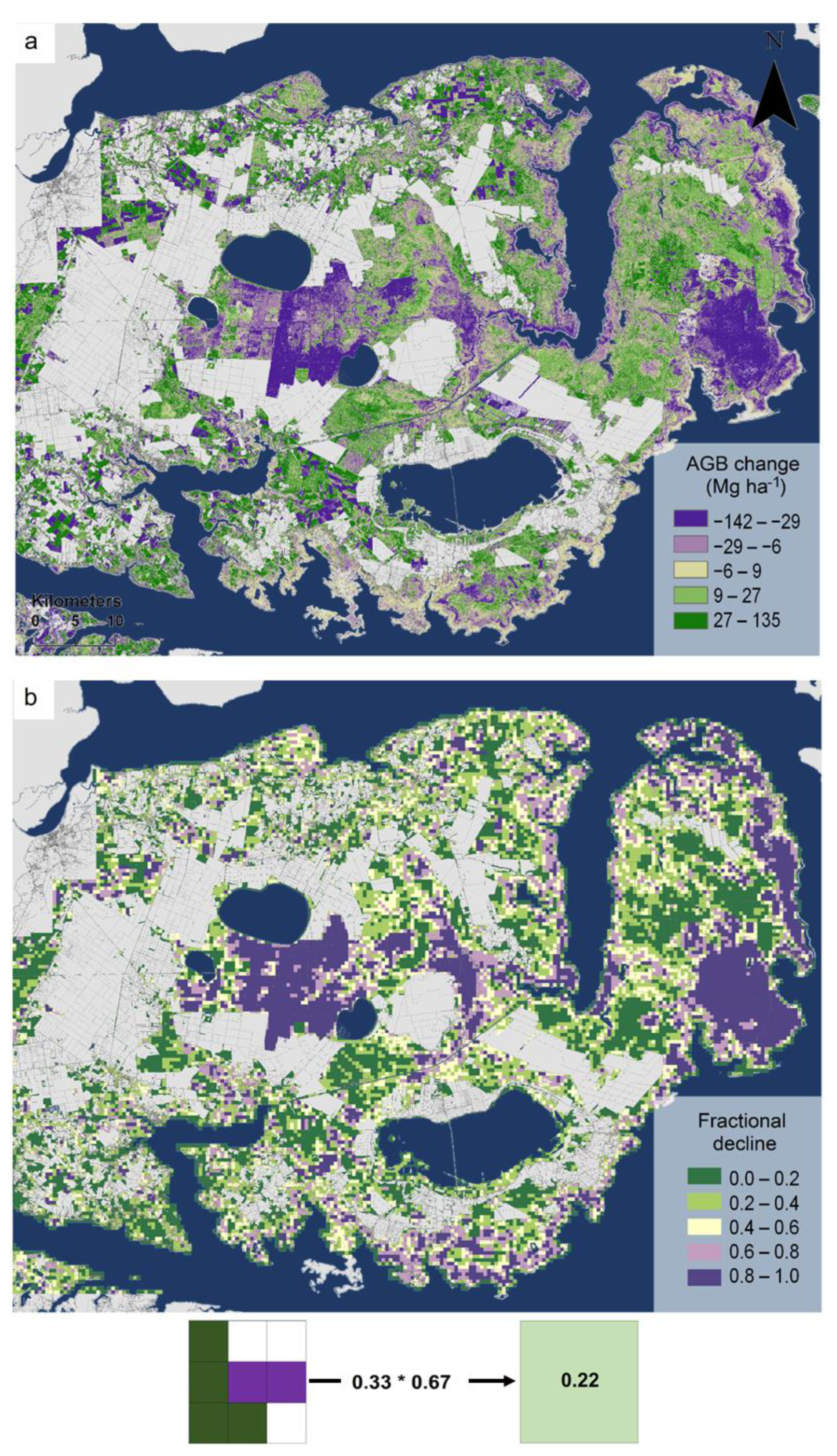
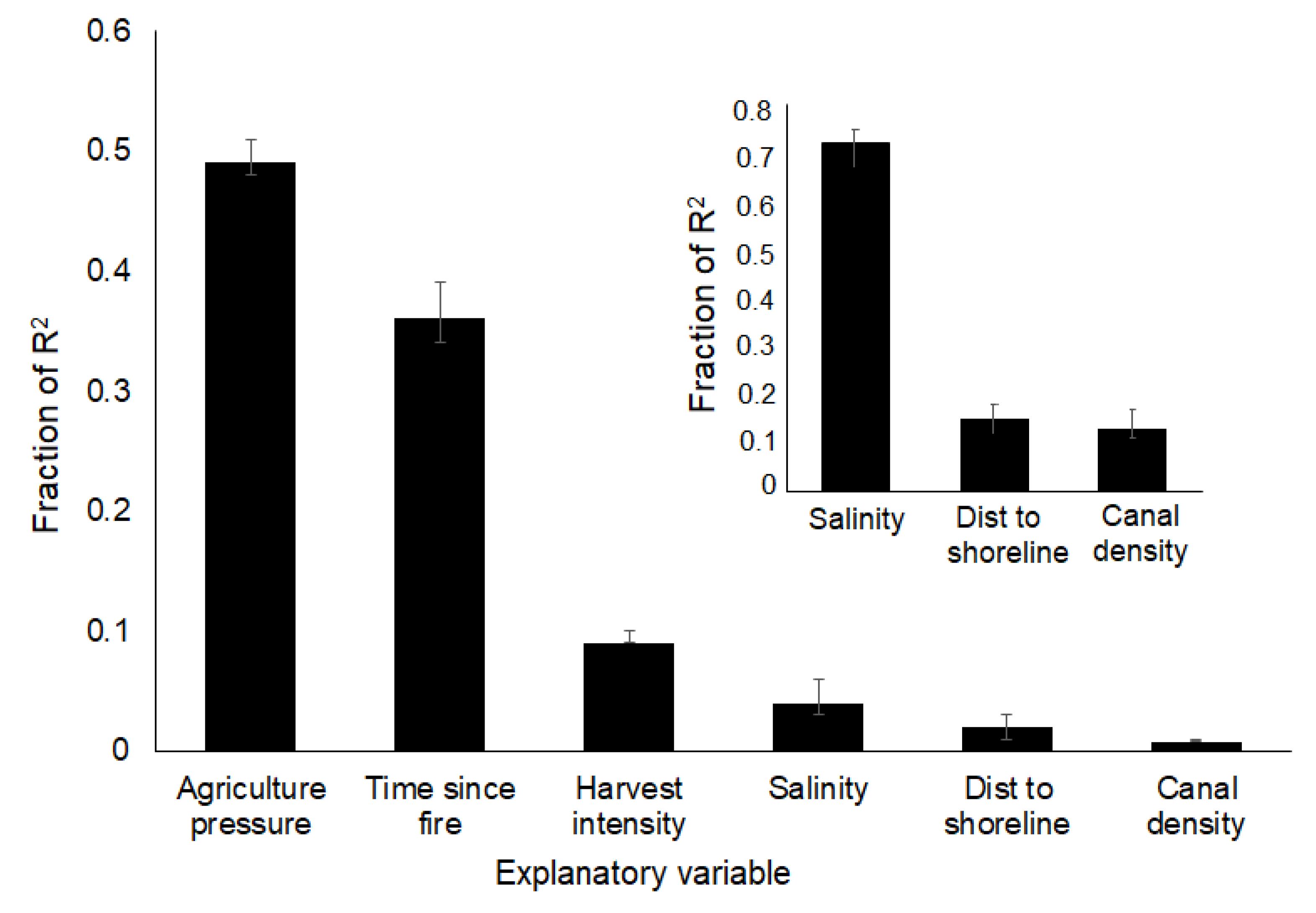

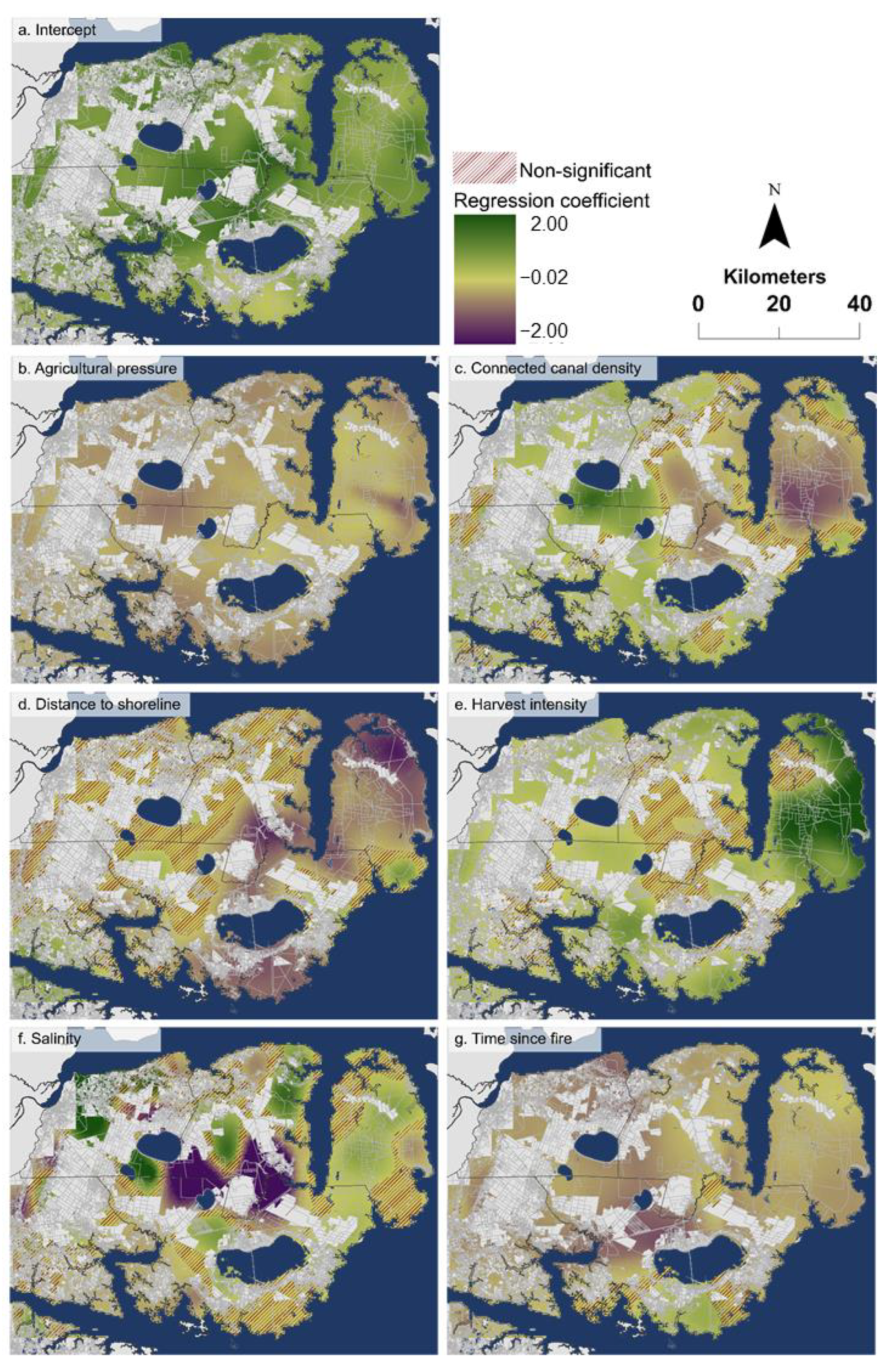


| Description | Base Data | Year | Data Source | |
|---|---|---|---|---|
| Land Use Drivers | ||||
| Agricultural pressure | Gravity model, number of neighboring agriculture cells within a search distance and weighted by distance | CDL, Cropscape | 2001, 2014 | NASS |
| Fallow pressure | Gravity model, number of neighboring fallow cells within a search distance and weighted by distance | CDL, Cropscape | 2001, 2014 | NASS |
| Harvest intensity | Threshold applied to between-year mean NDVI change to create binary outputs of harvest/acute event, summed across years | NDVI | 2001–2014 | Google Earth Engine |
| Natural Disturbance Drivers | ||||
| Time since fire | Using fire perimeters and year of fire, assigned number of years since fire across the landscape | Vector file | Current | MTBS |
| Sea Level Rise Drivers | ||||
| Connected canal density | Line density of only those canals connected to open water in study area, with influence at 1000 m distance | NHD | Current | USGS |
| Distance to estuarine shoreline | Euclidean distance (km) to estuarine shoreline | NHD | Current | USGS |
| Fast storm surge | Fast storm surge categories | Vector file | Current | NC Onemap |
| Flow accumulation | Flow accumulation | DEM | 2014 | Derived |
| Flow direction | Flow direction | DEM | 2014 | Derived |
| Salinity | Inverse distance weighting interpolation of average salinity (ppt) from 2001 to 2014 | STORET | 2001–2014 | EPA |
| Mean precipitation deviation | Yearly (2001–2014) average precipitation difference (mm) from historical norm (1990–2000) | 2001–2014 | Google Earth Engine | |
| MHHW adjusted elevation * | Elevation (m) adjusted by current mean higher high water (MHHW) | MHHW, DEM | 2014 | Derived |
| Minimum temperature deviation | Yearly (2001–2014) minimum temperature difference (degrees Celsius) from historical norm (1990–2000) | 2001–2014 | Google Earth Engine | |
| Slow storm surge | Slow storm surge categories | Vector file | Current | NC Onemap |
| (a) OLS | (b) GWR | |||
|---|---|---|---|---|
| Coefficient | Standard Error | Coefficient Mean (Range) | Standard Error Mean (Range) | |
| Intercept ***+ | 0.891 | 0.009 | 0.825 (0.120, 1.765) | 0.054 (0.026, 0.273) |
| Agricultural pressure ***+ | −0.431 | 0.006 | −0.387 (−1.140, −0.075) | 0.029 (0.015, 0.232) |
| Connected canal density ***+ | 0.084 | 0.013 | 0.168 (−1.308, 1.629) | 0.075 (0.026, 0.198) |
| Time since fire ***+ | −0.471 | 0.007 | −0.398 (−1.250, 0.507) | 0.048 (0.014, 0.311) |
| Harvest intensity ***+ | 0.160 | 0.012 | 0.186 (−0.225, 2.573) | 0.058 (0.028, 0.238) |
| Distance to shoreline *+ | −0.015 | 0.008 | −0.119 (−1.872, 0.895) | 0.101 (0.030, 0.375) |
| Salinity ***+ | −0.049 | 0.008 | 0.003 (−5.128, 5.210) | 0.117 (0.017, 1.000) |
Publisher’s Note: MDPI stays neutral with regard to jurisdictional claims in published maps and institutional affiliations. |
© 2021 by the authors. Licensee MDPI, Basel, Switzerland. This article is an open access article distributed under the terms and conditions of the Creative Commons Attribution (CC BY) license (https://creativecommons.org/licenses/by/4.0/).
Share and Cite
Smart, L.S.; Vukomanovic, J.; Taillie, P.J.; Singh, K.K.; Smith, J.W. Quantifying Drivers of Coastal Forest Carbon Decline Highlights Opportunities for Targeted Human Interventions. Land 2021, 10, 752. https://doi.org/10.3390/land10070752
Smart LS, Vukomanovic J, Taillie PJ, Singh KK, Smith JW. Quantifying Drivers of Coastal Forest Carbon Decline Highlights Opportunities for Targeted Human Interventions. Land. 2021; 10(7):752. https://doi.org/10.3390/land10070752
Chicago/Turabian StyleSmart, Lindsey S., Jelena Vukomanovic, Paul J. Taillie, Kunwar K. Singh, and Jordan W. Smith. 2021. "Quantifying Drivers of Coastal Forest Carbon Decline Highlights Opportunities for Targeted Human Interventions" Land 10, no. 7: 752. https://doi.org/10.3390/land10070752
APA StyleSmart, L. S., Vukomanovic, J., Taillie, P. J., Singh, K. K., & Smith, J. W. (2021). Quantifying Drivers of Coastal Forest Carbon Decline Highlights Opportunities for Targeted Human Interventions. Land, 10(7), 752. https://doi.org/10.3390/land10070752






